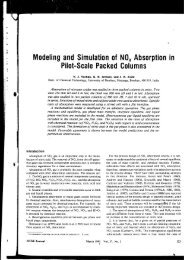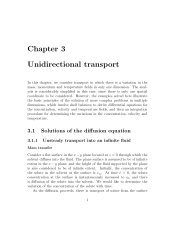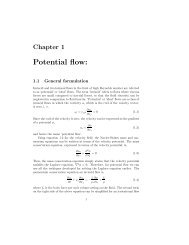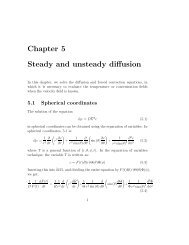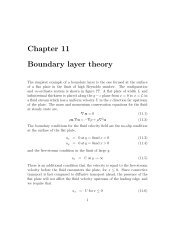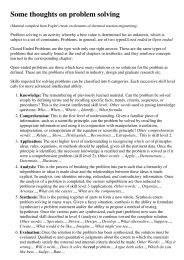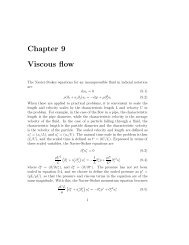You also want an ePaper? Increase the reach of your titles
YUMPU automatically turns print PDFs into web optimized ePapers that Google loves.
4 CHAPTER 1. POTENTIAL FLOW:where n is the outward unit normal at the surfaces bounding the fluid. Therefore,the kinetic energy of the fluid can be expressed only in terms of the potentialand normal velocity at the bounding surfaces. It follows that if the normalvelocity at all bounding surfaces is zero, then the kinetic energy is zero, whichimplies that the fluid velocity is zero throughout the domain.It is possible to prove a ‘uniqueness theorem’ for potential <strong>flow</strong>s, whichstates that the potential <strong>flow</strong> solution is unique if the normal velocity boundaryconditions are specified on all boundaries. To prove this, we first assume thatthe potential <strong>flow</strong> solution is not unique, and that there are two potential <strong>flow</strong>solutions, u and u ∗ , which satisfy the same normal velocity boundary conditions,u i n i = u ∗ i n i on the bounding surfaces of the <strong>flow</strong>. Consider the integral overthe fluid domain V , ∫I = dV (u ∗ i − u i )(u ∗ i − u i ) (1.15)VSince the integrand is always positive, the integral also has to be positive. For apotential <strong>flow</strong>, this integral can be rewritten by expressing the velocity in termsof the velocity potential, and using integration by parts as follows.∫I = dV (u ∗ i − u i) ∂(φ∗ − φ)V∂x i∫= dV∂∫((u ∗ i∂x − u i)(φ ∗ − φ) − dV (φ ∗ − φ) ∂(u∗ i − u i)(1.16)i ∂x iVThe second integral on the right side of equation 1.16 is zero due to the incompressibilitycondition, while the first integral can be expressed as a surfaceintegral using the divergence theorem,∫I = dS(φ ∗ − φ)(u ∗ i − u i )n iSV= 0 (1.17)Here, we have used the condition that the two velocity fields satisfy the samenormal velocity conditions on the boundaries, so that (u ∗ i − u i)n i is zero on allboundaries.We had earlier assumed that u ∗ and u are different velocity fields, in whichcase the integral I has to be positive. However, we have proved in equation 1.17that I is zero if the normal velocity fields at all surfaces are equal. Therefore,this implies, that it is not possible to have two different potential <strong>flow</strong> solutionswhich satisfy the same normal velocity boundary conditions at all the boundingsurfaces, and the solutions for the potential <strong>flow</strong> equations is unique if the normalvelocity conditions are specified at all boundaries.Another general result is the ‘minimum energy theorem’, which states thatthe kinetic energy of a potential <strong>flow</strong> is less than or equal to the kinetic energyof any other <strong>flow</strong> that satisfies the same normal velocity boundary conditionsat the bounding surfaces. Let us consider two velocity profiles, u i and u ∗ i , bothof which satisfy the same normal velocity boundary conditions at the bounding







